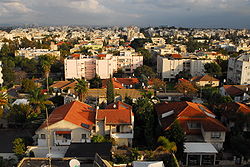 |
| view of Raanana, courtesy, Wikipedia |
During the time of Joshua,
the area that is now Raanana was allotted to the tribe of Menashe, in the
southwestern-most region close to the tribal territory of Dan. Long given over
to swampland, in 1921, a plot of land was purchased in the area by the Ahuza Society
branch in New York through the Palestine Land Development Company. On April 2, 1922,
two wagons left the corner of Lilienblum and Herzl Streets in Tel Aviv carrying four "Ahuza" members,
three laborers and two armed watchmen. After a five-hour journey, they unloaded
their baggage at the place destined to become Raanana.
In its early days, the
settlement was actually called "Ahuza Aleph – New York". The Arabs of
the region called it "Little America" as most of its residents were
English speakers who came from New York. Later it was renamed
"Ra'anania" and finally, "Ra'anana" as its official name.
The settlement was built along, and around, Ahuza Street, its main thoroughfare. Initially there were many economic difficulties, but they were gradually overcome. Between 1925 and 1927, the Community House, which would house a variety of public institutions, including the secretariat, clinic, synagogue, meeting place for local committee meetings, assembly hall, culture room, school, kindergarten, clinic, and post office, was built. An attempt was made to raise cattle as the mainstay of the economy, later changing over to the citrus crop. In the latter half of the 20s going into the 30s, rich groundwater table was tapped, and middle-class immigrants of the Fourth Aliyah and later newcomers were absorbed. In 1931, Raanana elected its first mayor, Baruch Ostrovsky, a Ukrainian-born educator from the United States. He remained mayor throughout the British Mandate period and the early years of Israeli independence during which time, Raanana was given local council status (1936).
With the crisis in citrus farming during World
War II, the inhabitants changed over to mixed farming and made the first beginnings in
industry. In the 1940s, two housing
quarters for Yemenite and other immigrants were built with contributions
from Zionists in the United States and South Africa. In 1947, Bessie Gotsfeld, an American Religious Zionist activist who had made aliyah in 1929, founded Kfar Batya children's village in the western part of Raanana for those children who had survived the Holocaust. By 1948, during Israel’s War of Independence,
Raanana was a town of 3,000 residents but grew quickly after the war when ma'barot (refugee camp)
inhabitants were given permanent housing. In 1958, the Loewenstein Hospital was established and became the only
rehabilitation hospital operated by Clalit Health Services, Israel's largest
health care provider.
Raanana
belonged to the outer ring of the Tel Aviv conurbation and developed various industries as
well as agriculture. Over the years, most of Raanana's farmland became built-up
areas. In 1981, it was declared a city.
There is an industrial zone in the north of the
city, which is home to the Renanim
shopping mall and many high-tech companies, including Emblaze, Hewlett-Packard, NICE Systems, SAP, NCR Corporation (formerly Retalix), Comverse, Red Hat, Waze (prior to Google acquisition), Texas Instruments, Arm Holdings and ZoomInfo. In addition, Microsoft's head office in Israel and Amdocs are located in an office complex at the eastern edge of the
city, close to Raanana Junction, where Highway 4 meets
Ahuza Street.
Raanana is also home to
the Open University of Israel and Raanana College.
The park of Raanana is the largest urban park in the Sharon region. The Founders Museum presents the story of Ra'anana's original
settlers until the city achieved local council status in 1936. Raanana Park Amphitheatre has been the venue for musical acts such as Backstreet Boys, Evanescence, Alice Cooper, Lauryn Hill, Tori Amos, Chick Corea, Ian Anderson, Ziggy Marley, The Cranberries, The Stranglers, Seal, Brian Wilson, Regina Spektor, Blondie and Pet Shop Boys.
The main soccer club of the city is Hapoel Ra'anana. In basketball, the city is represented by Maccabi Raanana who play in the National League. The Raanana Roosters are the local rugby team, and the area is a center of the rugby union in Israel, with Rugby Israel being based there. With a large population of American expatriates, the Raanana Express is an inaugural team in the Israel Baseball League.
No comments:
Post a Comment